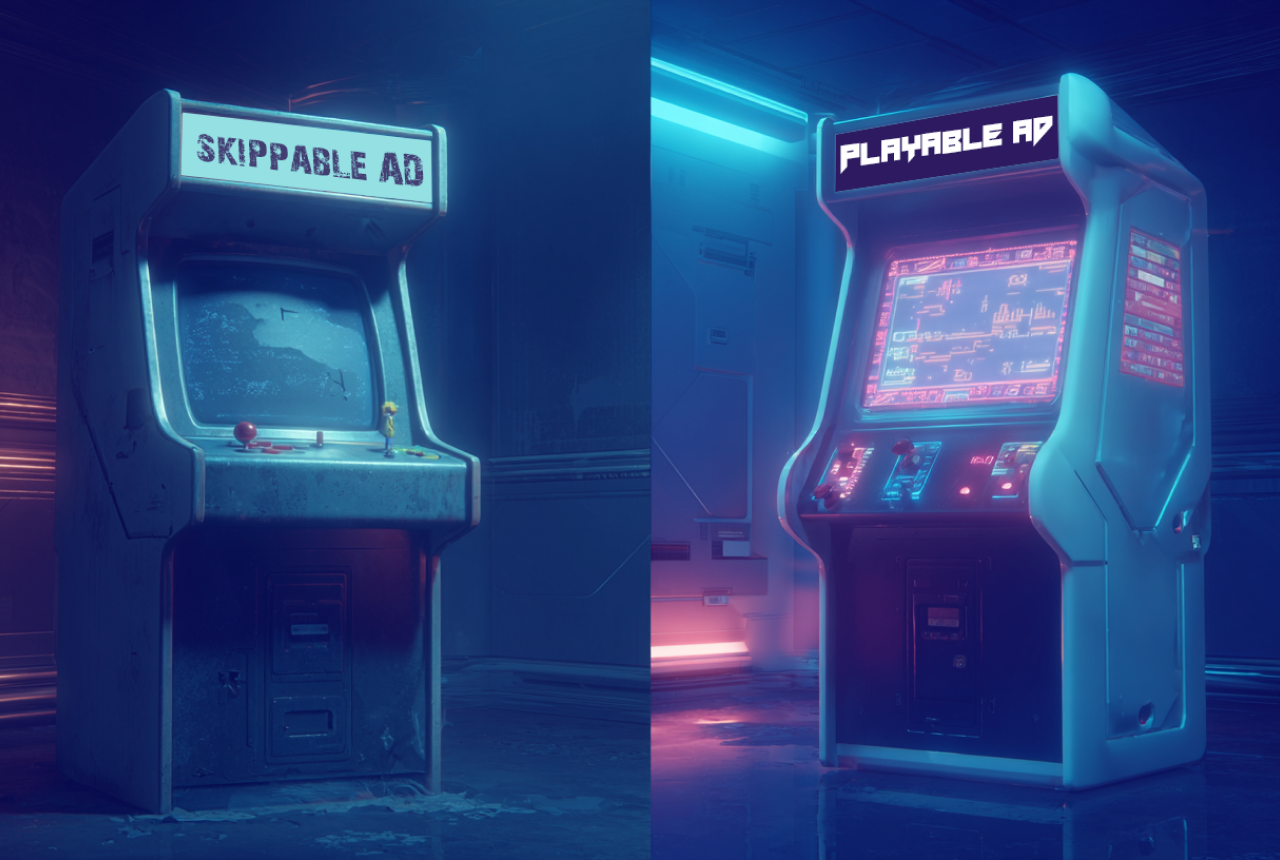In-Game Advertising
The Ad Industry Adapts to a Privacy-First World with In-Game Blended Ads

A New Age in Advertising
As the digital landscape constantly shifts, those who don't stay informed risk falling behind. The world of mobile gaming is no exception, with blended in-game ads emerging as a dominant force. Overlooking this trend could mean missing out on significant opportunities.
Blended in-game ads go beyond ordinary forms of advertising; they're cleverly designed to integrate seamlessly with the game's environment. Meaning players experience ads not as interruptions, but as a part of the game itself.
But why are these ads becoming so popular? What happens to those who don't use this method? Keep reading to learn about the benefits and importance of blended in-game advertising.
Audience Targeting: The Changing Landscape Of Advertising
In April 2021, Apple released iOS 14.5, which would shake up the advertising game. Apart from multiple other changes, the new OS version introduced the App Tracking Transparency (ATT) privacy framework.
With the new update, all Apple devices that are running the latest version, and going forward, all new versions, app publishers will need to ask for user permission to track certain metrics and access device identifiers, most prominently the Apple Identifier for Advertisers (IDFA).
IDFA was designed to provide advertisers and app owners the opportunity to anonymously identify a mobile device and start collecting usage information for extensive targeting while advertising.
Facebook was, unsurprisingly, forecasted as the most hit platform with Apple’s new changes. Many experts predicted that the new change would cost Facebook roughly $12 billion in ad revenue.
While the final figures may be different, Facebook has suffered significantly in terms of its share price, and analysts are predicting we will witness Facebook’s ad revenue drop for the first time (Source: Forbes).
Roughly 14 months before this, Google announced that it will phase out third-party cookies in Google Chrome by 2022. The process, however, was delayed to 2023 and is now set for 2024.
Google has said that they want advertisers to adjust their ad strategies to be less intrusive, giving them additional time (Source: Bloomberg)
With tech leaders embracing the less intrusive ad approach, the gaming industry will also be impacted by these measures.
In-Game Advertising in a Cookieless World
Digital advertising traditionally relies on device and user behavior targeting, but the imminent phase-out of third-party cookies demands adaptation from advertisers. Amidst this change, in-game blended ads have emerged as the preferred strategy for advertisers seeking higher viewability and game publishers aiming to enhance the ad experience for players.
As in-game advertising garners more attention from advertisers, contextual targeting advancements have gained momentum. Contextual targeting appears as a substitute for audience targeting via third-party cookies, especially across gaming channels. Gaming channels offer advertisers an ideal platform to maintain broad reach while targeting their relevant audiences based on contextual factors such as genre, subgenre, platform, geography, time, and day. With in-game advertising, which isn't solely dependent on audience behavior data, advertisers can capitalize on the inherently contextual nature of games in their targeted advertising strategies.
But what are blended in-game advertising and in-game blended ads exactly, and how can top gaming publishers make more money with them?
Don’t Miss It! Mobile Game Monetization Strategies
What is Blended In-Game Advertising?
Blended in-game advertising is a method where advertisements are intricately woven into the fabric of a game's environment and narrative. Instead of presenting ads as external interruptions, they are incorporated as elements that players can naturally interact with or observe.
This strategy offers a less intrusive way to showcase brands, making the gaming experience smoother while still effectively reaching audiences.
But how does this blended in-game advertising work, and why is it making waves in the mobile gaming sector?
In the vast arena of mobile gaming, where players seek uninterrupted experiences and publishers aim for sustainable mobile game monetization strategies, blended in-game advertising emerges as a harmonious solution.
Unlike traditional ads, which can abruptly disrupt a player's journey, blended ads are ingeniously integrated into the gaming environment. They're designed to feel less like ads and more like a native part of the storyline or gameplay. The seamless integration of brand appeal within the game fabric, coupled with the ability to refine the target audience, makes this approach ideal for utilizing contextual targeting options, and reducing dependence on third-party data.
The brilliance of this approach is its subtlety. According to Newzoo, 47% of gamers expressed a higher likelihood to purchase a brand featured in their favorite game. Moreover, players remain immersed in their gaming experience, encountering billboards promoting real-world brands as they navigate virtual cities or interact with seamlessly integrated branded items within the game's environment.
This creates a win-win situation: gamers enjoy a smoother experience, and advertisers gain a receptive audience.
Blended in-game advertising isn't just a fleeting trend; it's a strategic evolution responding to both user preferences and the needs of the advertising industry.
Uncovering In-Game Blended Ads
From the perspective of an avid gamer, the emergence of in-game blended ads feels like a breath of fresh air.
Remember that racing game where you zoomed past billboards that subtly showcased real-world brands? Or that role-playing game where your character donned branded attire? That's blended advertising in action.
By integrating promotional content directly into the gaming narrative, these ads ensure that players remain engaged and advertisers deliver their message in a contextually relevant manner.
For advertisers, it's about respecting the player's space while effectively communicating a brand's message.
It's not merely about plastering logos everywhere, but about finding the perfect spot where the ad can shine without overshadowing the gaming experience.
In today's fast-paced digital age, where capturing a user's attention is harder than ever, in-game blended ads offer a golden opportunity.
By seamlessly marrying advertising with storytelling, brands can effectively engage an audience without alienating them. It's a win-win for both players and brands, and as the gaming world continues to evolve, it's a strategy that's set to play an ever-important role.
So, for advertisers looking to make a genuine impact, it's time to think blended, think immersive, and most importantly, think player-first.
Examples of Blended In-Game Advertising
Understanding blended in-game advertising is the first step to witnessing the next step is to see this innovative strategy in action.
Visual examples often provide the clearest insight, and with examples of blended in-game ads, the balance between player immersion and effective advertising becomes evident. In the upcoming sections, we'll spotlight games that have successfully integrated these ads, enriching the gameplay and amplifying brand messages.
While the adoption of in-game blended ads is in full swing, it is by no means a new concept. Going as far back as 1983, players would serve Budweiser beer to bar patrons in the game ‘Tapper.’ A few years later, we witnessed the Ford Simulator, which was designed to promote the 1988 Ford line of automobiles.

Source: Play DOSGames
Since then, we have seen extensive usage of ads in-game, and placement opportunities have only increased. Publishers can now opt for a variety of ad placements inside the game, enabling advertisers to reach the audience seamlessly.
These ads often replicate real-life ad experiences, easing the viewers and making these ads feel appropriate and non-intrusive.
Here are ways and examples publishers and brands can leverage in-game blended ads.
Blended Displays
Ever wandered across a huge billboard or a wall mural advertisement in your neighborhood? Similar to real life, in-game ads can be blended into displays inside a game.
Tony Hawk: Ride, launched in 2009 for PlayStation 3, Xbox 360, and Wii, featured advertisements for Stride, a chewing gum brand. Players encountered these ads on billboards and various in-game locations, and they had the opportunity to unlock achievements related to the branded content.

Source: Clearcode
Advertisers can use these natural displays inside games to make the ad placement as seamless as possible without disrupting the natural flow of the play.
In-Game Product Placements
In-game items have been part of games for a long time. But these items are now enabling brands to drive brand viewability and recognition.
For example, players in NBA 2K22 can play their way to upgrade their apparel and footwear. The game features a long list of brands that showcase their items in-game, most prominently Nike and Drake's OVO. Brands such as Union, Just Don, 2HR Set, and Visitor have also been a part of the game since NBA 2K20.

Similarly, players can consume Monster Energy in Death Stranding to achieve a temporary stamina boost of 10%.

Source: VG247
Game Sponsorships
While brands have been sponsoring in-game items and product placements, we have also seen complete brand-based game sponsorships or level sponsorships to maximize their reach.
This is not a new concept and has been around for decades. In the 1990s, for example, Cool Spot and Spot Goes To Hollywood featured the red spot on the 7Up logo as the main character. The spot flew through the game on a 7Up bottle and completed the missions.

Another example is, Riot Games has announced a new digital sponsorship banner with Mastercard that will appear during League of Legends (LoL) esports broadcasts across the world.

Benefits Of Using Blended In-Game Ads
Blended in-game ads present a unique opportunity for advertisers to reach audiences, without interrupting the gaming experience. This approach not only fosters positive brand perception but also enhances recall.
By blending ads into the game environment, brands can build more meaningful interactions with players.
Now, let's explore the key advantages:
1. Immersive advertising experiences: In-game ads integrate interactive elements, making gameplay more enjoyable and engaging for players.
2. Non-intrusive ads: Blended in-game ads don’t remove players from the game reducing disruption and maintaining the core experience.
3. Player-centric approach: Elevates the game experience by introducing familiar brands, adding a touch of realism to a virtual world.
4. Contextual advertising: Enables precise message placement and targets the right audience, in line with the context of the gaming for maximum impact.
5. Long-Term value and brand reputation: This strategy establishes long-term value for brands. It contributes significantly to building and maintaining a positive brand reputation.
6. Bolster brand awareness: In-game advertising enhances brand engagement and recall, fostering greater awareness among the gaming community.
7. Conversion potential: These ads offer substantial conversion potential. They turn player engagement into tangible results, bridging the gap between interaction and action.
The Growth of Blended Ads and The Future of Gaming
Blended in-game ads take a different approach from traditional advertising where players are taken out of the game. This ad format provides an extremely lucrative opportunity for game publishers.
Despite their adoption by leading gaming brands, a significant portion of the market remains untapped.
As privacy concerns increasingly dominate the gaming and advertising sectors, in-game blended ads emerge as a viable alternative.
With the decline of third-party data reliance, we're on the cusp of a major shift towards blended advertising. Brands would do well to embrace this change.
Conclusion
Advertisers need to develop experience-driven ad strategies and leverage the potential of immersive storytelling through blended in-game advertising to survive in the evolving digital advertising landscape where audience targeting becomes a challenge. This approach helps them stay connected with relevant audiences in the gaming worlds and even unlock access to new ones.
With iion’s game advertising platform, immersiion, advertisers can precisely reach audiences by implementing the right advertising strategy, while delivering immersive experiences to audiences targeted by gaming context.
With immersiion, advertisers can set up, customize, activate, and measure campaigns across all gaming environments:
- Precisely target audiences using advanced contextual targeting options for brand-safe and relevant ad placements.
- Access their target audiences in entirely new environments where audiences are actively engaged.
- Expand their marketing channels and enhance their media mix with rich media formats.
- Run and measure campaigns that meet defined marketing objectives from awareness to conversion.
Curious about scaling your revenue with top-tier advertisers and in-game blended advertising?









.webp)















